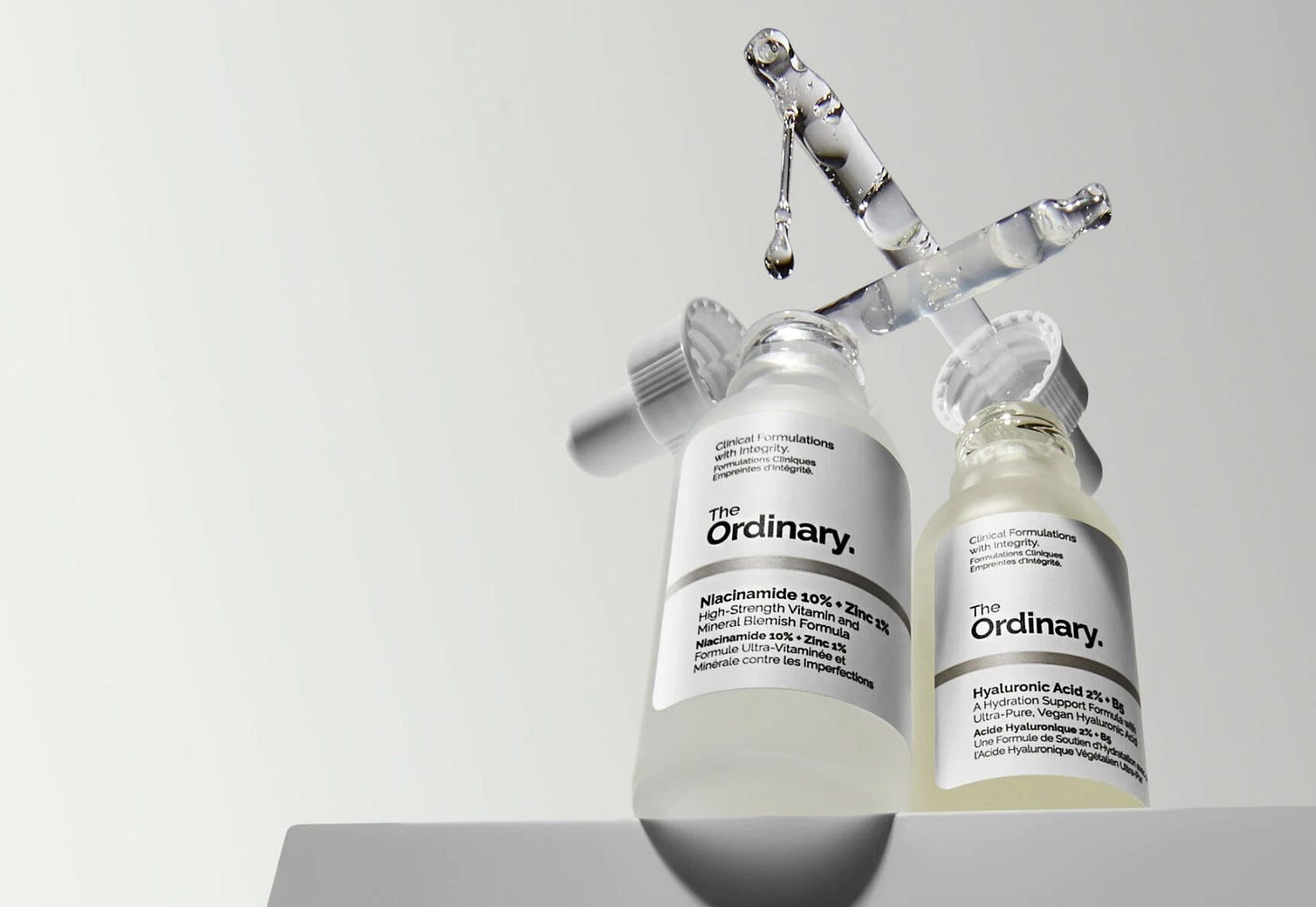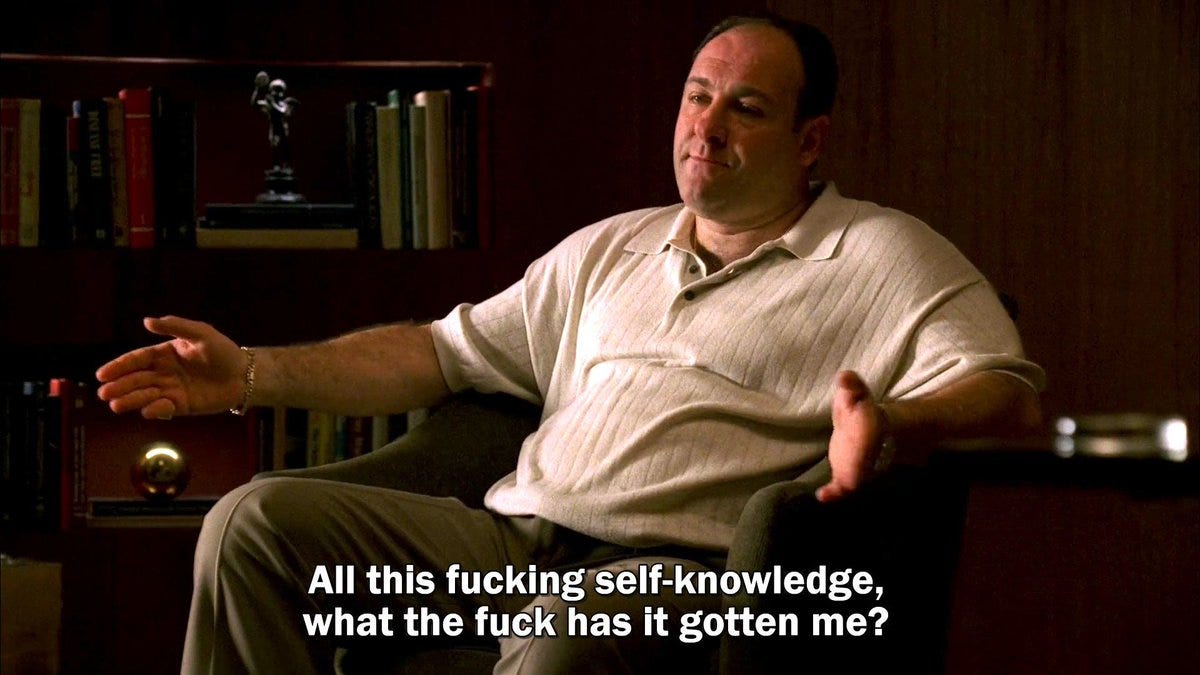Miles and miles of perfect skin
💰 What I’m investing in
🧴 A new era in skincare.
It’s hard to remember a time before The Ordinary.
Backtracking a little for the less beauty-inclined in the room: Iranian-Canadian entrepreneur Brandon Truaxe founded DECIEM The Abnormal Beauty Company in 2012. The Ordinary, launched in 2016, was one of 10 brands under the umbrella of DECIEM. After a few controversies, he passed away in 2019 at age 40.
Why is The Ordinary so revolutionary you ask? Instead of selling ready-made, potentially ineffective/full of filler products, it started selling actives with a clear concentration: Glycolic Acid 7%, Niacinamide 10% + Zinc 1% (a personal must-have), etc. in minimal packaging. Each product page does a tremendous job in explaining what effect you can expect from each active. Hyaluronic acid will boost hydration while glycolic acid will exfoliate skin. Two very different acids!
This is what skincare used to look like in 2003:
Beyoncé aside, this trio of products promises pure skin 24/7 and even though there’s a clear order in which to use the above skincare, nothing on the packaging tells me what key ingredients and actives will help me become worth it. Comparing acne-fighting products from L’Oréal versus Neutrogena versus Clarins was impossible without purchasing and trying all of them.
Back to the Ordinary: anyone can nowadays become a skin expert and the brand has set new industry standards. In 2024, L’Oréal products proudly showcase which ones contain hyaluronic acid, retinol or niacinamide. Those are now words that a customer knows and looks for.
I can pinpoint two other factors contributing to that widespread knowledge: in-depth conversations re: routines and products on Into The Gloss – founded in 2010, which then led to the creation of Glossier – and the rise to prominence of dermatologists such as Dr. Shereene Idriss.
The age of beauty shrouded in mystery (see: La Mer) is over.
Where is all that taking us?
Body skincare
Now that we’re all widely educated on how to reach our peak skin-wise, why stop at our faces? Let’s take it a step above cleansing, exfoliating and moisturising. Some brands are starting to address a few specific body concerns: tech neck? Nécessaire has a $65 neck serum. Ageing hands? Here’s a $75 hand cream, and a $249 “LED hand perfector.” I’m not condoning throwing money at the problem but simply commenting on a growing trend.
With a retinol hand cream (anti-ageing), a salicylic acid spray (against body acne) and an AHA gel (against keratosis pilaris), Soft Services is the one brand that manages to make unsexy body products desirable.
We’re about to see investments in new body-focused brands, and industry giants (L’Oréal, Estée Lauder, Unilever) will follow suit and launch copycat products.
Age-defying treatments
I’m not talking about slowing down ageing, either with the current offer in topical skincare (retinol, vitamin C) and injectables (Botox, Hyaluronic Acid filler), but reversing the effects of age.
Topically: I’m starting to see Tiktok content featuring an active I had never heard of before: volufiline. It’s a plant extract that supposedly mimics the effects of injectables like Botox and filler. Derms seem loathe to recommend the product as it’s not yet backed with not enough research. As of now, all the products I see for sale seem sketchy at best. My prediction: it’s not going to be as much of a buzzword as hyaluronic acid but we’ll see multiple brands launch their own products. They’ll be marketed as “filler-like.”
Surgically: Anyone who’s seen recent pictures of Christina Aguilera and Lindsey Lohan can attest that visible filler is so passé. So what are they doing? Some keywords: topical and injected growth factors, biostimulators (Sculptra). And the pendulum seems to be swinging back to actual surgery (blepharoplasties for lids and under eyes, face-lifts) after many years of non-surgical procedures (injectables). We’ll see visible results on the general population in a few months/years. My prediction: instead of a divide between tasteful and overdone work, the class divide will become apparent between visible and undetectable work, for a Dorian Gray-like appearance. It’s going to skew the perception of age again, with Gen Z apparently ageing more rapidly than millennials.
📈 Bullish news
$1.2B for tortilla chips! PepsiCo acquires Siete Foods. [Thingtesting]
Alcohol-free Champagne. LVMH Bets on Booze-Free Bubbles at $100-Plus a Bottle. [WSJ] I discussed the rise of nonalcoholic drinks in edition #1.
Being rich, now with training wheels. Millionaire parents are taking Gen Z kids to bespoke conventions to prepare them for the $90 trillion Great Wealth Transfer [Fortune]
Finally? Pharma eyes male birth control pill for Gen Z [Axios]
Remember how I wasn’t so keen re: smart glasses in edition #4? Someone Put Facial Recognition Tech onto Meta's Smart Glasses to Instantly Dox Strangers [404 media]
Does the world need an H&M beauty flagship? It also carries other brands such as e.l.f. and Kylie Cosmetics.
Out: touch screens. In: buttons. [WSJ]
MrBeast acquired Vouch, the LinkedIn for the creator economy. [Business Insider]
📉 Bearish news
Fidelity has cut its estimate of X’s value by 79% since Musk’s purchase [TechCrunch]
Is Ozempic killing Weight Watchers? Its stock is down more than 90% since the beginning of the year, and they just fired their CEO. [QZ]
Hedi Slimane out at Celine; Michael Rider in. [NYT]
The Paris Market Report
The Americanisation of Paris must be stopped, or at least slowed down. As someone who refuses to queue for food on principle, I’m starting to feel stifled 🎻







